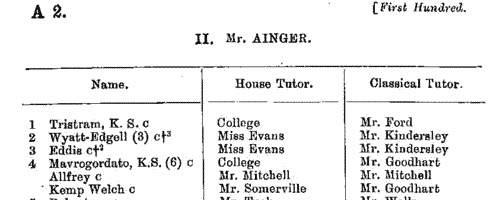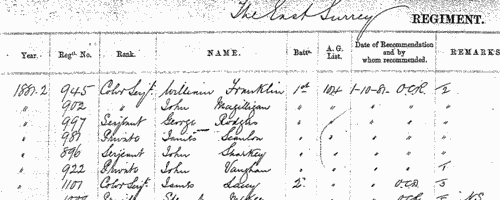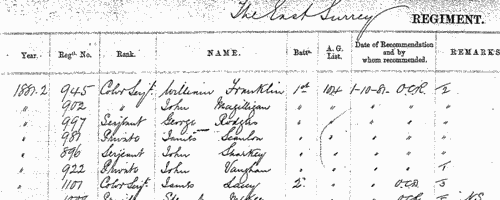Allcock Surname Ancestry ResultsOur indexes 1000-1999 include entries for the spelling 'allcock'. In the period you have requested, we have the following 399 records (displaying 331 to 340): Single Surname Subscription | | | Buying all 399 results of this search individually would cost £2,402.00. But you can have free access to all 399 records for a year, to view, to save and print, for £100. Save £2,302.00. More... |
These sample scans are from the original record. You will get scans of the full pages or articles where the surname you searched for has been found. Your web browser may prevent the sample windows from opening; in this case please change your browser settings to allow pop-up windows from this site. Eton College boys and masters
(1900)
Printed lists of boys attending Eton College were issued each School-Time or term. This is the list for Lent School-Time, 1900. The governors and masters of the schools are given first: then the names of a scholar elected for King's in December 1899, and the names and ages of 16 scholars elected for Eton in July 1899, 12 of whom had been admitted. Winners of the Newcastle Scholarship, two each year, back to 1829 (here indexed from 1859 onwards), and of the various college scholarships and prizes for 1899, precede the Distinctions in Trials (examinations) for December 1899. The First Hundred and Certificate examination list for Election 1899 list the boys in order of merit and with the marks awarded in Classics, Mathematics, Scripture Knowledge and History. The Certificate list is divided into First, Second and Third Classes, Passed, and Failed. The names of examiners and absentees are also given. Then follow the main lists of all the pupils, arranged by class. For every boy his position in class, surname, house tutor's name and classical tutor's name, are given; and evey boy's entry is annotated with details of his prizes during his whole period at the school. In the fifth forms the list for each class is divided into four parts, divided by a dotted line, then a wavy line, and then a full line. The top fourth had all obtained distinction in the last trials; those above the wavy line had been classed in the last trials; next were the unclassed; and below the full line were those boys who had failed in the trials.
ALLCOCK. Cost: £6.00.  | Sample scan, click to enlarge

| Missing Next-of-Kin and Heirs-at-Law
(1900)
The Unclaimed Money Registry and Next-of-Kin Advertisement Office of F. H. Dougal & Co., on the Strand in London, published a comprehensive 'Index to Advertisements for Next of Kin, Heirs at Law, Legatees, &c., &c., who have been Advertised for to Claim Money and Property in Great Britain and all Parts of the World; also Annuitants, Shareholders, Intestates, Testators, Missing Friends, Creditors or their Representatives, Claimants, Unclaimed and Reclaimed Dividends and Stock, Citations, Administrations, Rewards for Certificates, Wills, Advertisements, &c., Claims, Unclaimed Balances, Packages, Addresses, Parish Clerks' Notices, Foreign Intestates, &c., &c.' The original list was compiled about 1880, but from materials dating back even into the 18th century: most of the references belong to 1850 to 1880. For each entry only a name is given, sometimes with a placename added in brackets: there may be a reference number, but there is no key by which the original advertisement may be traced. The enquirer of the time had to remit £1 for a 'Full and Authentic Copy of the Original Advertisement, together with name and date of newspaper in which the same appeared'. This appendix to the list was issued in about 1900.ALLCOCK. Cost: £4.00.  | Sample scan, click to enlarge

|  Outstanding soldiers of The King's (Shropshire Light Infantry)
(1881-1901) Outstanding soldiers of The King's (Shropshire Light Infantry)
(1881-1901)
Each year the best soldiers of the regiment were chosen for long service and good conduct medals. This register gives rank, name, regimental number, and date of recommendation. (The sample scan is from the East Surrey regiment). The register is essentially a register of recommendations, annotated with details of the issue of the medals. Where no gratuity accompanied the medal, the entry is marked 'W. G.' (without gratuity); where, for one reason or another, the medal was not issued, the entry is marked 'N. S.' (not sanctioned) and struck through. The regiment was based on the 53rd Regimental District - Shrewsbury. The 1st battalion embarked for Egypt in 1882, took part in the Egyptian war ("Egypt, 1882"), and by 1885 was stationed on Malta; returning to Egypt in that year, it took part in the Soudan expedition ("Suakin, 1885") and then was sent back to Malta in 1887. The battalion was sent on to Hong Kong in 1891, and transferred to India in 1894; in 1895 it was at Fort William. The 2nd battalion returned to England from Bombay in 1881, and in 1885 was at Woolwich. The battalion was sent to Ireland in 1886; back to England in 1894 (at Portland in 1895); and in 1899 off to South Africa, where it added "South Africa, 1899-1902" and "Paardeberg" to the regimental honours.ALLCOCK. Cost: £8.00.  | Sample scan, click to enlarge

|  Outstanding soldiers of the Rifle Brigade (The Prince Consort's Own)
(1881-1901) Outstanding soldiers of the Rifle Brigade (The Prince Consort's Own)
(1881-1901)
Each year the best soldiers of the brigade were chosen for long service and good conduct medals. This register gives rank, name, regimental number, and date of recommendation. (The sample scan is from the East Surrey regiment). The register is essentially a register of recommendations, annotated with details of the issue of the medals. Where no gratuity accompanied the medal, the entry is marked 'W. G.' (without gratuity); where, for one reason or another, the medal was not issued, the entry is marked 'N. S.' (not sanctioned) and struck through. The rifle depot was at Winchester. There were four line battalions. The 1st battalion embarked for Bombay in 1880, and by 1885 was based at Belgaum. From 1885 to 1888 it served in Burma (adding "Burma, 1885-1887" to the regimental honours), returning to India before being sent (in 1894) to Hong Kong. In 1896 the 1st battalion was moved to Singapore, returning to England in 1898, and then being sent to South Africa ("South Africa, 1899-1902", "Defence of Ladysmith", "Relief of Ladysmith"). The 2nd battalion returned from Gibraltar to Ireland in 1880, moved to England in 1885 and was stationed at Aldershot; having served again in Ireland 1890 to 1895, it was sent from England to Malta in 1897, and to Crete and Egypt in 1898, taking part in the Soudan campaign ("Khartoum"). It was transferred to South Africa in 1899. The 3rd battalion was sent from Ireland to England in 1882, and in 1885 was at Aldershot; at the end of that year it was moved to Gibraltar; back to England in 1886; and embarked for Egypt 19 October 1887; went on to South Africa in 1888; and thence to India in 1889. In 1895 the 3rd battalion was serving at Rawal Pindee. The 4th battalion embarked for India 20 October 1873, and by 1885 was at Jhansi in Bengal; it was sent to Burma ("Burma, 1885-1887"), returned to England 27 January 1890, and in 1895 was at Aldershot. In 1896 the 4th battalion moved to Ireland, and in 1900 was sent to South Africa. ALLCOCK. Cost: £8.00.  | Sample scan, click to enlarge

|  London Metropolitan Police
(1892-1902) London Metropolitan Police
(1892-1902)
The London Metropolitan Police Register of Joiners (MEPO 4/336) lists policemen joining the force 1 January 1892 to 23 June 1902 (warrant numbers 77319 to 88811). The register is alphabetical, in so far as the recruits are listed chronologically grouped under first letter of surname. It gives Date of Appointment, Name, Number of Warrant, Cause of Removal from Force (resigned, dismissed, promoted or died), and Date of Removal. A final column of 'Remarks' is largely blank, but occasionally gives an alias or a cross-reference to another warrant number.ALLCOCK. Cost: £8.00.  | Sample scan, click to enlarge

|  British artillerymen fighting in South Africa
(1899-1902) British artillerymen fighting in South Africa
(1899-1902)
The Queen Victoria's South Africa Medal was awarded (after her death, in the event) to all who had served honourably in the various campaigns in the Boer War. Returns were made from each unit, and consolidated into nominal roll, of which this is the one for the Royal Artillery. Confusingly, the ledgers used had originally been printed for a register of men transferred (or re-transferred after mobilization) to 1st Class Army Reserve. All the original column headings were therefore struck through, and the roll was prepared with this information: Date of Issue; Regimental Number; Rank; Name; Unit; Medal (a 1 indicating that a medal was awarded); [number of] Clasps; the reference to the source in the original returns, usually starting with AG for papers in the hands of the Adjutant-General, and 68/Art/ for the Royal Artillery records. The final column, normally left blank, was occasionally used for explanatory remarks.ALLCOCK. Cost: £8.00.  | Sample scan, click to enlarge

|  Queen's South Africa Medal: Royal Field Artillery: 86th Battery
(1901-1905) Queen's South Africa Medal: Royal Field Artillery: 86th Battery
(1901-1905)
The nominal roll for the Queen Victoria's South Africa Medal - awarded (after her death, in the event) to all who had served honourably in the various campaigns in the Boer War - was compiled from these returns from the individual units. Two sets of form were completed. The main one, as in the sample scan, dates from 1901 and gives regimental number, rank, and full name (surname first), followed by a series of columns relating to different actions - Belmont, Modder River, Paardeberg, Dreifontein, Wepener, Johannesburg, Diamond Hill, Belfast, Wittebergen, Defence of Kimberley, Relief of Kimberley, Defence of Mafeking, Relief of Mafeking, Cape Colony, Orange Free State, Transvaal, Rhodesia, Talana, Elandslaagte, Tugela Heights, Defence of Ladysmith, Relief of Ladysmith, Laing's Nek, and Natal; each entitled the man to a separate clasp to the medal, and a tick or a Yes in the appropriate column indicates the man's actual physical presence in that battle. A final column for remarks is important in those cases where the man was no longer in the unit, by removal, death or desertion. The second form that sometimes occurs was returned in 1905, and covers men entitled to the Second South African War Medal and Clasps. It lists men by number, rank and name, checks whether they had claimed the Queen's South Africa Medal, and then enquires as to their suitability as to three Colony Clasps, which could be awarded for service in the Cape, Orange Free, or Transvaal; whether entitled to Date Clasps (South Africa 1901 and South Africa 1902); whether also entitled to the King's South Africa Medal; any other corps in which served in South Africa; and remarks (such as becoming non-effective, forfeiture, &c.) WO 100/143ALLCOCK. Cost: £8.00.  | Sample scan, click to enlarge

|  Queen's South Africa Medal: Royal Horse Artillery: Q Battery
(1901-1905) Queen's South Africa Medal: Royal Horse Artillery: Q Battery
(1901-1905)
The nominal roll for the Queen Victoria's South Africa Medal - awarded (after her death, in the event) to all who had served honourably in the various campaigns in the Boer War - was compiled from these returns from the individual units. Two sets of form were completed. The main one, as in the sample scan, dates from 1901 and gives regimental number, rank, and full name (surname first), followed by a series of columns relating to different actions - Belmont, Modder River, Paardeberg, Dreifontein, Wepener, Johannesburg, Diamond Hill, Belfast, Wittebergen, Defence of Kimberley, Relief of Kimberley, Defence of Mafeking, Relief of Mafeking, Cape Colony, Orange Free State, Transvaal, Rhodesia, Talana, Elandslaagte, Tugela Heights, Defence of Ladysmith, Relief of Ladysmith, Laing's Nek, and Natal; each entitled the man to a separate clasp to the medal, and a tick or a Yes in the appropriate column indicates the man's actual physical presence in that battle. A final column for remarks is important in those cases where the man was no longer in the unit, by removal, death or desertion. The second form that sometimes occurs was returned in 1905, and covers men entitled to the Second South African War Medal and Clasps. It lists men by number, rank and name, checks whether they had claimed the Queen's South Africa Medal, and then enquires as to their suitability as to three Colony Clasps, which could be awarded for service in the Cape, Orange Free, or Transvaal; whether entitled to Date Clasps (South Africa 1901 and South Africa 1902); whether also entitled to the King's South Africa Medal; any other corps in which served in South Africa; and remarks (such as becoming non-effective, forfeiture, &c.) WO 100/139ALLCOCK. Cost: £8.00.  | Sample scan, click to enlarge

| City of London Chess Team (1905)
Members of the local chess team named in the results of tournaments recorded in the British Chess Magazine
ALLCOCK. Cost: £8.00.  | Sample scan, click to enlarge

| Essex Chess Team (1905)
Members of the local chess team named in the results of tournaments recorded in the British Chess Magazine
ALLCOCK. Cost: £8.00.  | Sample scan, click to enlarge

|
Research your ancestry, family history, genealogy and one-name study by direct access to original records and archives indexed by surname.
|













